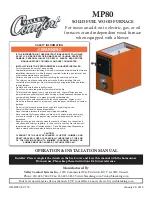
16
Cuatro-3 90
Instructions for use
When setting the appliance, turn the locking all the way to the right.
If necessary, leave the door ajar for 10 minutes. Do not open the door wide, as the
window will remain cold. If the door is shut during this time, smoke will condense on the
glass and form soot. Move the air supply slider all the way to the right “
+
” only when
starting the appliance.
Prevent white glow and over-fi ring.
5.3 INSTRUCTIONS WHILE STOKING
After approx. 10 minutes, the appliance will be burning fi ercely. You can now top it up
with a few larger blocks of wood. Turn the locking all the way to the left when these
blocks are burning well, and close the door.
Using the air supply slider you can now adjust the air supply for further combustion.
Make sure the appliance burns quietly.
Note: Once you have got the appliance going, leave the air supply slider in the centre
position for optimal combustion. Your appliance will then be much cleaner and more
effi cient (more heat, less topping up).
We recommend that you maintain a substantial layer of ash (2 - 3 cm). This not only
forms a protective layer for the base of the appliance but also signifi cantly reduces
consumption of fuel and allows new wood to catch light easier.
When loading the appliance with fuel, three blocks measuring ca. 28 cm long and
30 cm perimeter is suffi cient. Do not add more fuel until the previous fuel has burned
down to the charcoal stage. This is after approximately 45 minutes. The fl ames are then
almost no longer visible. Do not leave the door open longer than necessary.
If there is insuffi cient burning material in the fi rebed to light a new fuel charge, excessive
smoke emission can occur. Refuelling must be carried out onto a suffi cient quantity
of glowing embers and ash that the new fuel charge will ignite in a reasonable period.
If there are too few embers in the fi re bed, add suitable kindling to prevent excessive
smoke.
ê
Centre position
Combustion air supply slider
Control range of primary air supply (by grate)
Control range of secondary and tertiary air supply
















































